

Mrs. Warren's Profession. Summary[edit] The story centres on the relationship between Mrs Kitty Warren and her daughter, Vivie.
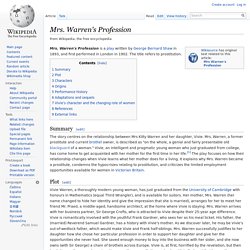
Mrs. Warren, a former prostitute and current brothel owner, is described as "on the whole, a genial and fairly presentable old blackguard of a woman. " Vivie, an intelligent and pragmatic young woman who just graduated from college, has come home to get acquainted with her mother for the first time in her life.[1] The play focuses on how their relationship changes when Vivie learns what her mother does for a living. It explains why Mrs. Plot[edit] Vivie Warren, a thoroughly modern young woman, has just graduated from the University of Cambridge with honours in Mathematics (equal Third Wrangler), and is available for suitors. The Memory Keeper's Daughter. The Memory Keeper's Daughter is a novel by American author Kim Edwards that tells the story of a man who gives away his newborn daughter, who has Down syndrome, to one of the nurses.
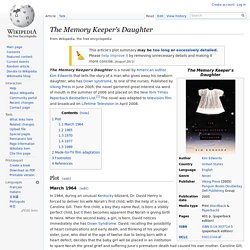
Published by Viking Press in June 2005, the novel garnered great interest via word of mouth in the summer of 2006 and placed on the New York Times Paperback Bestsellers List.[1] The novel was adapted to television film and broadcast on Lifetime Television in April 2008. Plot[edit] Major Barbara. The Court Theatre 1904–1907 (1907) Major Barbara is a three act play by George Bernard Shaw, written and premiered in 1905 and first published in 1907.
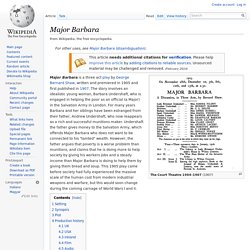
The story involves an idealistic young woman, Barbara Undershaft, who is engaged in helping the poor as an official (a Major) in the Salvation Army in London. For many years Barbara and her siblings have been estranged from their father, Andrew Undershaft, who now reappears as a rich and successful munitions maker. Undershaft the father gives money to the Salvation Army, which offends Major Barbara who does not want to be connected to his "tainted" wealth. However, the father argues that poverty is a worse problem than munitions, and claims that he is doing more to help society by giving his workers jobs and a steady income than Major Barbara is doing to help them by giving them bread and soup.
Love Medicine. Love Medicine is Louise Erdrich’s first novel, published in 1984.

Erdrich revised and expanded the novel for an edition issued in 1993, and then revised it again for the 2009 edition. The book explores 60 years in the lives of a small group of Chippewa (aka Ojibwa or Anishinaabe) living on the Turtle Mountain Indian Reservation in North Dakota. Love Medicine won the 1984 National Book Critics Circle Award. Overview[edit] The Loved One. The Loved One: An Anglo-American Tragedy (1948) is a short satirical novel by British novelist Evelyn Waugh about the funeral business in Los Angeles, the British expatriate community in Hollywood, and the film industry.
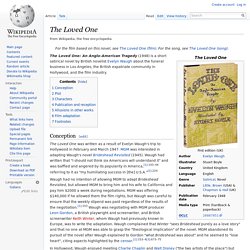
Conception[edit] The Loved One was written as a result of Evelyn Waugh's trip to Hollywood in February and March 1947. MGM was interested in adapting Waugh's novel Brideshead Revisited (1945). Lord Jim. Lord Jim is a novel by Joseph Conrad originally published as a serial in Blackwood's Magazine from October 1899 to November 1900.
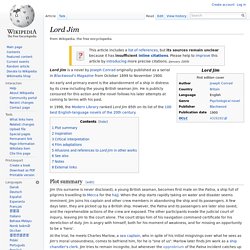
An early and primary event is the abandonment of a ship in distress by its crew including the young British seaman Jim. He is publicly censured for this action and the novel follows his later attempts at coming to terms with his past. Long Day's Journey into Night. Long Day's Journey into Night is a drama in four acts written by American playwright Eugene O'Neill in 1941–42 but only published in 1956.
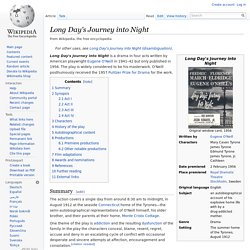
The play is widely considered to be his masterwork. O'Neill posthumously received the 1957 Pulitzer Prize for Drama for the work. Summary[edit] The action covers a single day from around 8:30 am to midnight, in August 1912 at the seaside Connecticut home of the Tyrones—the semi-autobiographical representations of O'Neill himself, his older brother, and their parents at their home, Monte Cristo Cottage. One theme of the play is addiction and the resulting dysfunction of the family. Synopsis[edit] Act I[edit] James Tyrone is an aging 65-year-old actor who had bought a "vehicle" play for himself and had established a reputation based on this one role with which he had toured for years. His wife Mary has recently returned from treatment for morphine addiction and has put on weight as a result.
Act II[edit] Their mother appears. Act III[edit] Act IV[edit] The Little Foxes. Program for the original Broadway production, starring Tallulah Bankhead as Regina Hubbard Giddens.
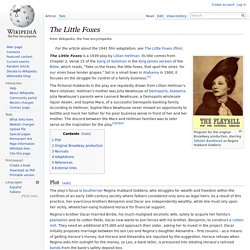
Letters from an American Farmer. Letters from an American Farmer is a series of letters written by French American writer J.
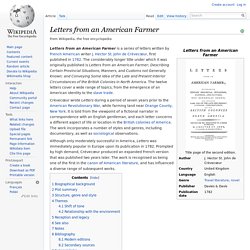
Hector St. John de Crèvecœur, first published in 1782. The considerably longer title under which it was originally published is Letters from an American Farmer; Describing Certain Provincial Situations, Manners, and Customs not Generally Known; and Conveying Some Idea of the Late and Present Interior Circumstances of the British Colonies in North America. Lady Windermere's Fan. Lady Windermere's Fan, A Play About a Good Woman is a four-act comedy by Oscar Wilde, first produced 22 February 1892 at the St James's Theatre in London.

The play was first published in 1893. Like many of Wilde's comedies, it bitingly satirises the morals of Victorian society, particularly marriage. The Kite Runner. The Kite Runner is the first novel by Afghan-American author Khaled Hosseini.[1] Published in 2003 by Riverhead Books, it tells the story of Amir, a young boy from the Wazir Akbar Khan district of Kabul, whose closest friend is Hassan, his father's young Hazara servant.
The story is set against a backdrop of tumultuous events, from the fall of Afghanistan's monarchy through the Soviet military intervention, the exodus of refugees to Pakistan and the United States, and the rise of the Taliban regime. Hosseini has commented that he considers The Kite Runner to be a father–son story, emphasizing the familial aspects of the narrative, an element that he continued to use in his later works.[2] Themes of guilt and redemption feature prominently in the novel,[3] with a pivotal scene depicting an act of violence against Hassan that Amir fails to prevent. The latter half of the book centers on Amir's attempts to atone for this transgression by rescuing Hassan's son over two decades later.
The Jungle. The Jungle is a 1906 novel written by the American journalist and novelist Upton Sinclair (1878–1968).[1] Sinclair wrote the novel to portray the harsh conditions and exploited lives of immigrants in the United States in Chicago and similar industrialized cities.[2] However, most readers were more concerned with his exposure of health violations and unsanitary practices in the American meatpacking industry during the early 20th century, based on an investigation he did for a socialist newspaper.
The book depicts working class poverty, the lack of social supports, harsh and unpleasant living and working conditions, and a hopelessness among many workers. These elements are contrasted with the deeply rooted corruption of people in power. A review by the writer Jack London called it, "the Uncle Tom's Cabin of wage slavery. Jane Eyre. Jane Eyre /ˈɛər/ (originally published as Jane Eyre: An Autobiography) is a novel by English writer Charlotte Brontë.
It was published on 16 October 1847 by Smith, Elder & Co. of London, England, under the pen name "Currer Bell. " The first American edition was released the following year by Harper & Brothers of New York. Plot[edit] Introduction[edit] The House of the Seven Gables. The House of the Seven Gables is a Gothic novel written beginning in mid-1850 by American author Nathaniel Hawthorne and published in April 1851 by Ticknor and Fields of Boston. The novel follows a New England family and their ancestral home. In the book, Hawthorne explores themes of guilt, retribution, and atonement and colors the tale with suggestions of the supernatural and witchcraft. The setting for the book was inspired by a gabled house in Salem belonging to Hawthorne's cousin Susanna Ingersoll and by ancestors of Hawthorne who had played a part in the Salem Witch Trials of 1692. The book was well received upon publication and later had a strong influence on the work of H. Hedda Gabler.
The title character Hedda, is considered one of the great dramatic roles in theatre, and portrayals have been known to vary widely.[1] Hedda's married name is Hedda Tesman; Gabler is her maiden name. On the subject of the title, Ibsen wrote: "My intention in giving it this name was to indicate that Hedda as a personality is to be regarded rather as her father's daughter than her husband's wife. "[2] The Good Soldier. Ghosts (play) A Gathering of Old Men. Frankenstein. Goethe's Faust. The Fall (Albert Camus novel) An Enemy of the People. The Dollmaker: Harriette Arnow: 9781439154434: Amazon.com: Books. A Doll's House. Anna Karenina. Anna Karenina ( Russian : «Анна Каренина» ; Russian pronunciation: [ˈanːə kɐˈrʲenʲɪnə] ) [ 1 ] is a novel by the Russian writer Leo Tolstoy , published in serial installments from 1873 to 1877 in the periodical The Russian Messenger . Tolstoy clashed with editor Mikhail Katkov over political issues that arose in the final installment (Tolstoy's unpopular views of volunteers going to Serbia); therefore, the novel's first complete appearance was in book form.
Widely regarded as a pinnacle in realist fiction , Tolstoy considered Anna Karenina his first true novel, when he came to consider War and Peace to be more than a novel. Fyodor Dostoevsky declared it to be "flawless as a work of art". Agnes of God. All My Sons. American Pastoral. The Apprenticeship of Duddy Kravitz (novel) Adam Bede. An American Tragedy. The Age of Innocence. Atonement (novel) The Brothers Karamazov. The Caretaker. Candida (play) Billy Budd. Brighton Rock (novel)